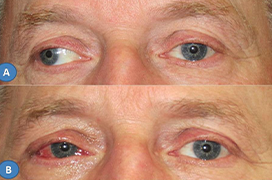Purpose: To evaluate the state of binocular vision, the amount and direction of the ocular deviation before and after strabismus surgery in adult patients and to monitor the occurrence of postoperative complications.
Methods: The retrospective study of 58 adult patients with selected types of strabismus who were surgically treated in the Eye Department of the Tomas Bata Regional Hospital in Zlín. We evaluated the amount and the degree of the primary ocular deviation and the binocular alignment before and after surgery, as well as the state of binocular vision after surgery and the occurrence of postoperative complications.
Results: The average deviation in convergent strabismus before surgery was +23.46 degrees, after surgery +6.6 degrees, in divergent strabismus it was -21.5 degrees, after surgery -1.48 degrees, for vertical strabismus before surgery +12.5 degrees and +3.75 degrees after surgery and in paralytic strabismus +20 degrees before surgery and +3 degrees postoperatively. Preoperatively there was effectively no binocular vision in up to 63.9% of patients, superposition occurred in 31%, fusion in 5.1%. No patient had stereopsis before surgery. After surgery, superposition was present in 39.7%, fusion in 31% and stereopsis in 6.9% of patients. Only 22.4% of patients experienced no binocular vision after surgery. Of the selected 21 patients out of 58 with an observation period of at least 3 years, we observed an improvement or development of binocular vision functions after surgery in 12 patients and no improvement of binocular vision functions in 9 patients. In the first group, 58.3% had a stable deviation throughout the follow-up period. While in the second group the deviation was stable in only 33.3%. We can assume that the improvement in binocular vision function after strabismus surgery, leads to a greater longer-term stability of postoperative deviations.
Conclusion: Strabismus surgery in adult patients is an effective and safe method, which is not only a cosmetic procedure used to adjust the position of the eyes, but also enables us to induce or improve the state of binocular vision functions.

